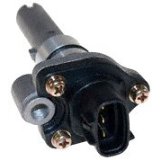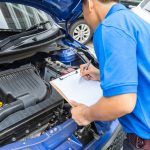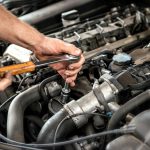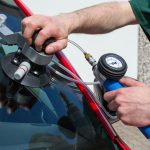Examples: defective vehicle speed sensors may cause improper torque converter clutch lockup as well as a cruise control malfunctions. A bad VSS can also cause inaccurate speedometer operation. It’s really nice to have the vehicle hoisted up on a lift so that the drive wheels can spin freely when you attempt to diagnose vehicle speed sensor problems.

When it is not possible to have a safe way to spin the wheels without moving the vehicle it may be necessary to take the vehicle in for proper diagnosis. There are a few checks that can be made to vehicle speed sensor without spinning the wheels. One test would be to connect an automotive electrical volt ohm meter and get an accurate resistance reading on the sensor.
The internal resistance of the sensors measured across the sensors terminals should typically range around 1000 ohms. But a good sensor can be lower or higher depending on the application. Going through a bunch of specifications it seems about 800 to 1400 ohms of resistance would be a passing grade.
Find Your Online Car Repair Manual Today! ->>
Wheel speed sensors and vehicle speed sensors are both permanent magnet voltage producing sensors and the procedures for testing both of these automotive electrical components is very similar. Factory service manuals include diagnostic routines and tree charts that can help technicians quickly diagnose VSS problems.
Locations of VSS sensors

Sometimes the first step of diagnosis finds the problem, which is a thorough visual inspection of the wiring harnesses and the sensors themselves. In the case of vehicle speed sensors and wheel speed sensors they are usually mounted underneath the vehicle where they can be susceptible to external damage.
Many models have the Vehicle speed sensor mounted in the output shaft area of the transmission housing. On rear wheel drive vehicles they can also be located in the rear differential area. On front-wheel-drive you will most often find the VSS mounted in the output shaft area of the transaxle.
The manufacturers do a good job of trying to hide these automotive electrical parts not from you but from external damage that can be caused by road debris potholes and chunks of ice. But unpredictable bounces from road debris have been known to collide with plastic sensor housings. A good visual inspection of the sensor itself and the attaching wiring harness can often end the diagnosis right there.
Permanent magnet wheel speed sensors and vehicle speed sensors are actually known to be very reliable. Often vehicles go to the junkyard with the original parts still installed on the automobile. If your check engine light comes on and you pull code for vehicle speed sensor you may want to start with the visual inspection first. If everything looks good then my advice would be to follow a diagnostic tree chart for the code.
Vehicle speed sensor problems can be serious because if there is no signal at all to the computer the transmission can go into a backup mode or better known as a limp home mode. Some manufacturers do a better job than others with this limp home mode. But with no vehicle speed sensor input even if the transmission shifts okay, poor fuel economy and unusual driving characteristics can be noticed by the driver.
The online auto repair blog has many more articles about problems you might have with your automobile. This next link takes you there from this page about vehicle speed sensor problems. Interested in a rundown of what else is covered here? The homepage can tell what kind of services is offered on the Internet at very low costs. You might be able to fix your own car with some online auto repair assistance.







